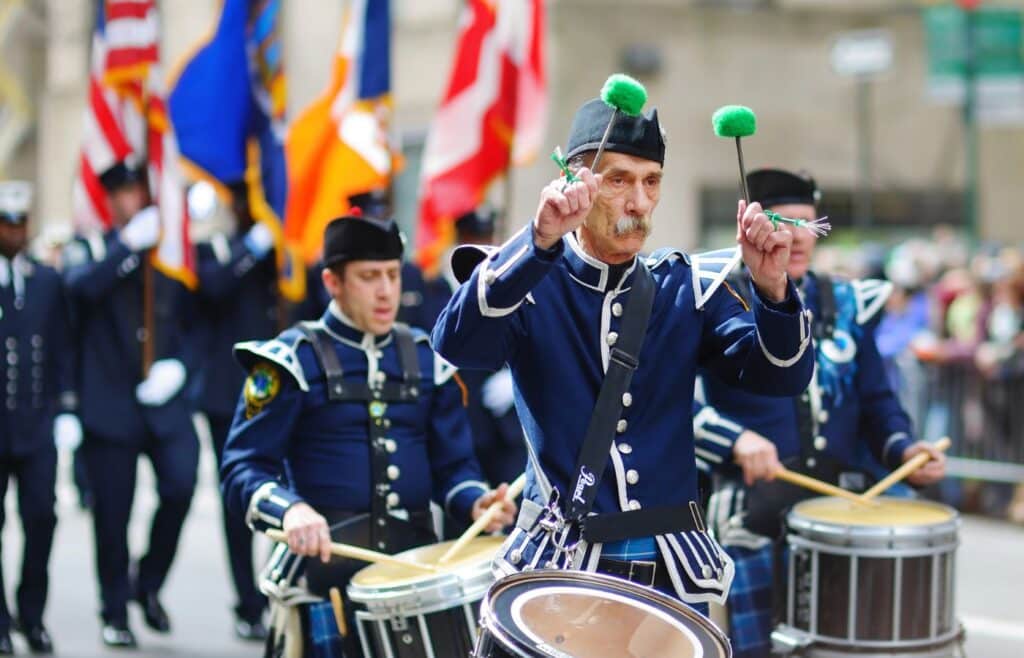Happy St. Patrick’s Day, everyone!
Today, we’re diving into a pot of gold filled with fun, surprising, and sometimes downright funny facts about this beloved holiday.

Whether you’re donning your greenest outfit or searching for four-leaf clovers, there’s more to March 17th than meets the eye.
So, grab your shamrocks and let’s explore some St. Patrick’s Day wonders that are sure to delight kids and adults alike:
1. Leprechauns Are Actually Shoemakers
According to Irish folklore, leprechauns are not just mischievous fairies; they are also shoemakers. This is why you often see them depicted with a hammer and shoes. They make shoes for other fairies!
2. The Original Color Wasn’t Green
While we associate St. Patrick’s Day with green, St. Patrick himself was originally associated with the color blue. It was only over centuries that green took over, thanks in part to Ireland’s lush landscape and the green in the Irish flag.
3. There’s a Leprechaun Registry
In Ireland, there’s an official leprechaun registry! The town of Carlingford, where leprechauns are said to be protected under European law, holds an annual leprechaun hunt (but don’t worry, it’s all in good fun).
4. St. Patrick Used the Shamrock for Teaching
St. Patrick used the three leaves of a shamrock to explain the Holy Trinity to the Irish, which is why the shamrock is a key symbol of St. Patrick’s Day. However, finding a four-leaf clover on this day is still considered extra lucky!
5. The Shortest St. Patrick’s Day Parade
In Hot Springs, Arkansas, there is a 98-foot-long parade that claims to be the shortest St. Patrick’s Day parade in the world. It’s a funny and quirky event that draws crowds despite its short length.
6. St. Patrick’s Day Was Once a Dry Holiday
For many years, St. Patrick’s Day was considered a more solemn, religious occasion in Ireland, and all pubs were closed for the day.
7. Ireland’s First St. Patrick’s Day Parade Wasn’t Until 1903
While St. Patrick’s Day has been celebrated for centuries, the first parade in Ireland didn’t happen until the early 20th century. Before that, the largest celebrations were held in places like New York City.
8. The World Turns Green
On St. Patrick’s Day, it’s not just people who celebrate by wearing green. Landmarks around the world, including the Sydney Opera House, the Empire State Building, and even the Great Wall of China, are lit up in green lights to mark the occasion.

9. Astronauts celebrate St. Patrick’s Day in space!
Astronauts on the International Space Station join in the St. Patrick’s Day festivities by sporting green garments, showcasing the holiday’s universal charm and how it’s celebrated even in outer space.
10. St. Patrick is famed for driving snakes out of Ireland.
According to legend, St. Patrick rid Ireland of snakes, symbolizing the expulsion of pagan ways. However, it’s believed that Ireland’s isolation since the Ice Age naturally kept snakes away.
11. JFK was the first U.S. president to attend a St. Patrick’s Day parade.
John F. Kennedy’s participation in a St. Patrick’s Day parade underscored the holiday’s significance in American culture and its special place among the Irish-American community.
12. St. Patrick’s Day parades are celebrated in Japan.
Tokyo has held its own St. Patrick’s Day parade since 1992, demonstrating the holiday’s widespread appeal and the global celebration of Irish culture.
13. The first St. Patrick’s Day celebration was in 1601 in Florida.
Recorded long before the American Revolution, this celebration marks the early presence of Irish culture in North America.

14. The White House fountain is dyed green for St. Patrick’s Day.
Since 2009, this tradition, inspired by Michelle Obama and reminiscent of Chicago’s river-dyeing, adds a festive touch to the White House’s St. Patrick’s Day celebrations.
15. The Leprechaun economy boosts sales of green items.
Leprechauns and all things green become especially popular during St. Patrick’s Day, significantly impacting various countries’ economies.
16. The Shamrock Shake is a McDonald’s tradition since 1970.
This mint-flavored, green milkshake is available around St. Patrick’s Day, becoming a seasonal favorite in the United States.
17. The largest collection of four-leaf clovers was gathered in Nebraska.
In 2004, someone in O’Neill amassed over 160,000 four-leaf clovers, setting a record for the largest collection.
18. The shamrock symbolizes peace in Irish political history.
Beyond its association with St. Patrick’s Day, the shamrock has served as a peace and reconciliation symbol during times of political conflict in Ireland.
19. St. Patrick wasn’t originally from Ireland.
Born in Roman Britain, St. Patrick later moved to Ireland, where he became one of its most celebrated figures.
20. St. Patrick’s real name was Maewyn Succat.
He adopted the name Patrick upon becoming a priest, marking the start of his journey as one of Ireland’s patron saints.
21. March 17th commemorates St. Patrick’s death.
This date is believed to be the day St. Patrick died in the 5th century, now celebrated as St. Patrick’s Day.
22. The first St. Patrick’s Day parade was in New York City, not Ireland.
In 1762, Irish soldiers in the English military organized the first parade, highlighting the Irish diaspora’s influence in the United States.
23. Chicago dyes its river green for St. Patrick’s Day.
This annual tradition is a vivid celebration of the holiday in the city. The tradition began in 1962, and it has become an iconic part of the city’s St. Patrick’s Day celebration.
24. St. Patrick is Ireland’s patron saint.
His contributions to spreading Christianity in Ireland have cemented his legacy.
25. St. Patrick’s Day is a public holiday in several regions.
Apart from Ireland, it’s also observed in Northern Ireland, Newfoundland and Labrador, and Montserrat.
26. St. Patrick was once a slave in Ireland.
Kidnapped by Irish raiders, he spent years in captivity before escaping and returning as a missionary.
27. St. Patrick returned to Ireland as a Christian missionary.
After escaping slavery, he dedicated his life to spreading Christianity across Ireland.
28. Four-leaf clovers are considered lucky but not linked to St. Patrick.
While a symbol of good luck, they don’t have a direct connection to the holiday’s religious origins.
29. New York City’s parade is the largest St. Patrick’s Day celebration.
It attracts over 2 million spectators each year, showcasing the city’s vibrant Irish community.
30. Ireland is known as the Emerald Isle.
Its lush greenery earns it this nickname, celebrated worldwide on St. Patrick’s Day.
31. The Irish language is called Gaeilge.
People honor Ireland’s cultural heritage by speaking the language.
This folklore adds a magical element to the holiday’s celebrations.
33. Corned beef and cabbage are traditional St. Patrick’s Day foods in the U.S.
These dishes become especially popular as a way to celebrate Irish culture.
34. Wearing green helps avoid pinches from leprechauns.
The tradition suggests that green makes you invisible to these mischievous fairies.
35. Over 33 million Americans claim Irish ancestry.
St. Patrick’s Day serves as a vibrant celebration of their heritage.
36. The shamrock is a national symbol of Ireland.
Thanks to St. Patrick, it represents Irish identity and culture.
37. St. Patrick’s Day started as a religious holiday.
It was originally observed by the Catholic Church and other Christian denominations as a feast day.
38. Leprechauns are considered mischievous fairies.
These green-coated creatures play a fun part in the holiday’s folklore.
39. St. Patrick’s Day is a public holiday in the Republic of Ireland.
Since 1903, it has been officially celebrated across the country.
40. St. Patrick lived in the 4th and 5th centuries.
His time was marked by significant changes in Ireland, including the spread of Christianity.
41. Guinness beer sales soar on St. Patrick’s Day.
Worldwide, over 13 million pints of Guinness are consumed on St. Patrick’s Day, more than doubling the usual daily sales.
42. Over 7,000 Irish pubs worldwide celebrate St. Patrick’s Day.
From Dubai to Argentina, these pubs highlight the holiday’s global footprint and the universal enjoyment of Irish hospitality.
43. St. Patrick is the national apostle of Ireland.
His missionary work and legacy have had a lasting impact on the country’s religious and cultural landscape.
St. Patrick’s Day FAQs
1. Why are green decorations everywhere on St. Patrick’s Day?
Green decorations adorn both public and private spaces on St. Patrick’s Day because green is considered the color of the day, symbolizing Ireland’s lush landscapes and its national color.
2. What does the pot of gold at the end of the rainbow symbolize?
The pot of gold at the end of the rainbow is a cherished myth in Irish folklore, symbolizing wealth and luck. It’s a fun element that adds to the magic of St. Patrick’s Day.
3. Why do people say “good luck” on St. Patrick’s Day?
Saying “good luck” on St. Patrick’s Day is common and often accompanies the search for a four-leaf clover, a symbol of good fortune in Irish tradition.
4. How does wearing green show Irish heritage?
Many people wear green on St. Patrick’s Day to express their connection to Ireland and its culture, as green is a national color representing the country’s verdant scenery.
5. What does St. Patrick’s Day celebrate?
St. Patrick’s Day celebrates Irish culture and the Christian faith of St. Patrick, Ireland’s patron saint. It’s a time for honoring his contributions and enjoying Irish traditions.
6. Is St. Patrick’s Day celebrated outside of Ireland?
Yes, St. Patrick’s Day is celebrated globally, including in New Zealand, where parades and festivities show the holiday’s widespread popularity beyond Irish shores.
7. What significance does March 17th hold?
March 17th is observed as the feast day of Saint Patrick, marking the date of his passing. It’s a significant day in the Christian calendar and a national holiday in Ireland.
8. What are common ways to celebrate St. Patrick’s Day?
St. Patrick’s Day is celebrated with music, dancing, traditional Irish foods, and public parades, embracing the cultural heritage of Ireland. Irish folklore stories, including tales of leprechauns and magic, are shared on St. Patrick’s Day to add to the holiday’s charm and celebrate the rich cultural heritage of Ireland. St. Patrick’s Day is a time for celebration with family and friends, enjoying a festive atmosphere regardless of one’s heritage, and participating in various cultural activities.
From the historical streets of Ireland to the vastness of space, St. Patrick’s Day brings together people from all walks of life to celebrate in unity and good cheer.
Happy St. Patrick’s Day, everyone—may it be filled with fun, laughter, and plenty of green!
Related Posts:
25 Fun Facts About Cinco de Mayo For Kids
50 Fun Thanksgiving Facts For Kids
100 Fun Food Facts to Surprise Your Kids
50 Spring-Inspired Fun Facts & Trivia For Kids
Calie Herbst, Editor-in-Chief of Milwaukee With Kids, has spent over a decade combining her experiences as a parent of three to create a hub for Milwaukee’s family adventures.
Her decade-long teaching career in Milwaukee Public Schools and academic background, including a Master’s in Teaching from Marquette University and dual B.A.s in Sociology and Spanish from the University of Wisconsin – Madison, fuel her passion for inclusive and engaging family content.
Calie is also a recognized voice in local media, contributing to WISN Channel 12 News, WTMJ Wisconsin Morning News, Fox 6’s Real Milwaukee, and B93.3.
Discover more about Calie’s journey and editorial approach on her About Page and Editorial Policy Page.









